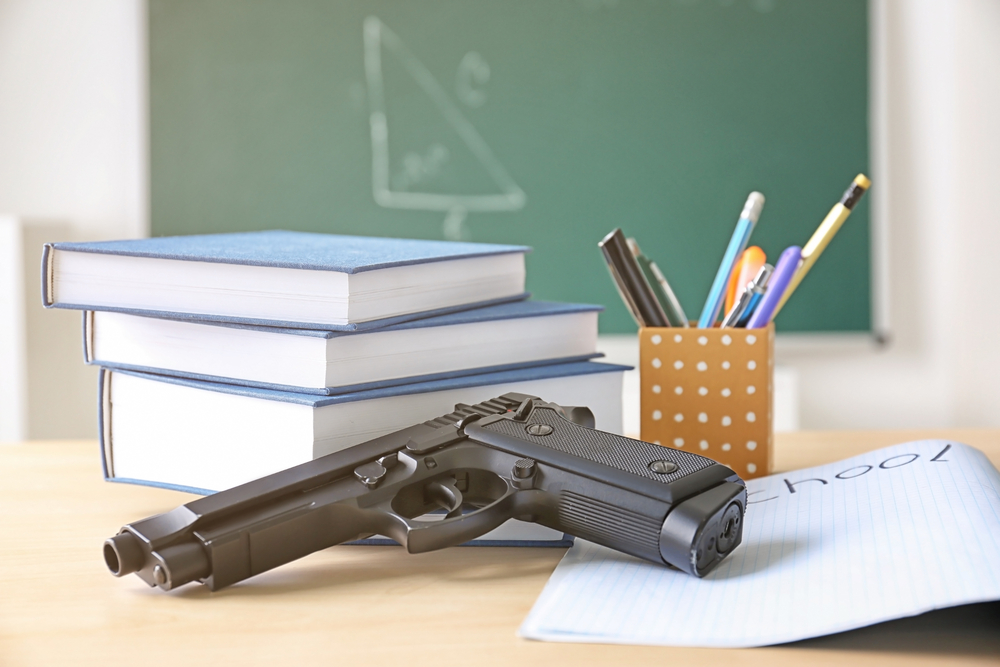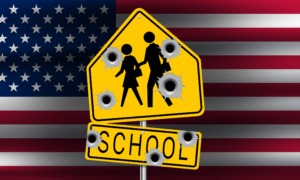The tragic shooting at Marjory Stoneman Douglas High School on Feb. 14, 2018 reawakened our national terror of school shootings and renewed a contentious national debate about the need for school safety, gun control and mental health. We are suddenly even more desperate to keep our students safe, mortified by the image of an enraged gunman roaming the halls of our children’s schools.
However, many of reactionary proposals being considered, from arming teachers on one extreme to outlawing guns on the other, overlook important facts regarding the vast majority of incidents involving guns at schools.

TACT2.com
Steve Parese
This debate began in earnest in April 1999, when Eric Harris and Dylan Klebold murdered 13 students and teachers at Columbine High School in Littleton, Colorado, before killing themselves. The issue came to the forefront of our national consciousness again in December 2012, when Adam Lanza murdered 20 students and six teachers at Sandy Hook Elementary in Newtown, Connecticut, then committed suicide as well.
Both times our nation reeled in shock as the names and faces of the slain played across our screens. Both times we sounded clarion calls for safer schools, stronger gun control or improved mental health. Both times the months passed, the horror faded, and the political will to create change slowly eroded.
In the few months since the massacre in Parkland, Florida, tens of thousands of students across the nation have walked out of classes to protest gun violence. Young leaders have emerged to confront politicians and demand solutions. I salute their determination to keep the issue on our national agenda, and I wonder: This time, will it finally be enough?
To paraphrase a quote attributed to George Santayana, a 19th-century philosopher: Those who fail to learn from the past are doomed to repeat it. Our decisions about how to respond effectively to the possibility of the next school shooting must be based on relevant facts about past incidents.
The statistics
An examination of a list of school shootings compiled by the Chicago Tribune in February reveals the following:
- In the 19 years since Columbine, there have been at least 117 incidents in which a gun was deliberately fired in or toward an American elementary, middle or high school.
- These incidents resulted in the deaths of at least 115 students and teachers (not including suicides); nonfatal gunshots injured another 198 people.
- In 30 percent of incidents, the shooter(s) committed suicide; nearly one-quarter of these were committed without physically harming classmates or adults.
- In 8 percent of incidents, the shooter was intercepted without injury to anyone.
- Of the 117-plus incidents, 14 involved the shooting death of two or more people; five resulted in five or more fatalities. These five incidents included:
- April 20, 1999: 13 killed in Littleton, Colorado
- March 21, 2005: 7 killed in Red Lake, Minnesota
- Oct. 2, 2006: 5 killed in Nickels Mine, Pennsylvania
- Dec. 14, 2012: 26 killed in Newtown, Connecticut
- Feb. 14, 2018: 17 killed in Parkland, Florida
Three types of shootings
What trends emerge from this examination? A quick review suggests three types of shooting incidents:
- Well-planned mass murders: The three deadliest shootings (Columbine, Sandy Hook and Parkland) comprised less than 3 percent of incidents, but were responsible for nearly half of all deaths. These well-planned assaults were committed by deeply disturbed young men, each of whom seemed determined to earn a measure of notoriety, leaving behind a long trail of warning signs that were only later fully appreciated.
- Gang or turf spillover issues: About 25 percent of incidents involving gun violence in schools were gang- or turf-related issues, criminal conflicts from the street that played out in school parking lots and athletic fields. Relatively few of these led to deaths, though many resulted in injuries.
- Desperate acts of vengeance: The majority of the remaining 72 percent of shooting incidents in schools were committed by boys, most 13 to 17 years old, with a common set of social-emotional traits. Based on limited information available about their personal lives, many shooters seemed to be physically or socially different from the norm. They frequently showed deficits in social-cognitive skills and were alienated by prosocial, age-appropriate peers. They often failed to buy in to academics or sports as a source of identity and recognition, instead connecting with counter-culture groups. Few had meaningful relationships with teachers, coaches or support workers. Most held grudges against specific adults or groups of classmates, and desperately wanted revenge. And of course, all had access to deadly firearms, about 80 percent within their own homes.
What conclusion can we draw from this examination of the past? While the most lethal shootings provoke the greatest fear, they are not representative of the majority of gun violence incidents, which are often perpetrated by a very different type of person than Klebold or Lanza or Nikolas Cruz, who has been charged but not convicted. How can we use our knowledge to channel our fear and outrage into strategies that actually make our schools and children safer?
Predictable phases of escalation
As the author of the TACT2 crisis intervention program, now in its 20th year, I have trained thousands of school staff members to respond calmly to disruptive, destructive and even dangerous situations and to see classroom crisis as a series of four predictable (and often preventable) phases. Each phase has its signs and symptoms, and when staff know what to look for, they are less likely to be taken by surprise.
- In the Warning Phase of a classroom crisis, staff generally see early signs of tension, agitation or anxiety as a troubled youth tries to avoid the problem. In the classroom, our goal is to prevent the budding crisis. We do this by offering distractions, acknowledging feelings and offering support.
- In the Escalation Phase, educators often observe much more intensity, hostility or panic as an upset youth actively makes his situation worse. Our goal with this highly escalated student is de-escalation. By giving him space, reducing stimuli or letting the student freely vent his emotions, we give him a chance to calm down.
- In the Crisis Phase, the youth has lost control verbally, emotionally and perhaps even physically. She presents an imminent danger to herself and/or others, so our goal is to protect her, ourselves and others. Skillful staff members do this by offering calm reassurances, redirecting unsafe behavior or moving the youth to a safer setting.
- Finally, in the Recovery Phase, the crisis has passed, and the youth is gradually regaining physical and emotional self-control. He may be tearful and trembling, anxious and uncertain. Our goal is resolution — to both resolve the current crisis and prevent the next one by calmly and thoroughly processing what just occurred.
Applying the Escalation Model to shootings
What if we apply this four-phase escalation model used in classrooms to our national crisis of school violence?
In the years before a school shooting, signs of the Warning Phase are often visible. Many school shooters seem to share some common traits — emotionally isolated, rejected by peers and lacking in social-emotional skills. A number have experienced childhood traumas and shown signs of associated mental health challenges. Many lost interest in school activities and lacked significant attachments to school staff. Instead, they found a sense of identity and recognition in counter-culture groups, and all had easy access to firearms.
Recommendation: Prevent deadly school shootings during the Warning Phase.
As a nation, we must dedicate resources to:
- Shift school culture from punishing negative behavior to encouraging positive behavior, thereby improving relationships with and increasing empathy toward those “misfits” who are frequently alienated.
- Strengthen services for high-risk students, including social-emotional learning, crisis counseling and mental health services, to ameliorate underlying issues that may contribute to any school violence.
- Reinforce security procedures to prevent dangerous people or weapons from entering the school and to respond quickly if they do.
In the days and weeks before tragic school violence, symptoms of the Escalation Phase might be seen. In the cases of Harris and Klebold, Lanza and Cruz, investigators later discovered large purchases of deadly firearms and munitions, hate-filled social media postings and pictures or even videos threatening mass violence.
But this pattern is not the norm for the desperate teen boys responsible for more than 50 percent of school shootings. Based on the limited information available, it seems that many of them may have experienced a triggering incident, such as an argument with a teacher or school administrator, a painful peer rejection or incident of bullying, or a serious fight with or abuse by parents.
Combined with significant background stress or prior trauma, these triggers may have nudged them over the edge. Few, perhaps, had access to the emotional support they needed, but all had access to guns.
Recommendation: De-escalate potentially violent crises during the Escalation Phase:
We must garner the political will and economic resources to:
- Restrict minors’ access to firearms, especially incredibly destructive assault rifles and ammunition that enable mass-murder fantasies.
- Train school staff (including support staff such as bus drivers, cafeteria workers, etc.) to recognize and report signs of trauma and abuse, and to respond assertively to incidents of social and physical bullying that may act as precursors of violence.
- Strengthen our federal reporting and investigative process when teachers, parents or neighbors observe preparations, allowing trained law enforcement and mental health specialists to respond quickly to realistic threats.
It is too late to prevent danger in the Crisis Phase, but not too late to limit it. By this point, a dangerous youth is approaching a school with deadly intent, sometimes planning to kill him/herself afterward. About one in four gun crises occurred in parking lots or athletic fields outside the school. Of those crises inside the building, one in 10 resulted in the student attempting or committing suicide, with no one else injured.
Recommendation: Protect students and staff, emotionally as well as physically, and limit danger in the Crisis Phase.
We must invest in strategies that promote genuine safety and security:
- Provide active-shooter training to staff and students, preparing them (as with fire drills) to react clearly and calmly in the event of an emergency.
- Make every locked-down classroom a self-contained safety zone by investing in tinted, bulletproof glass and reinforced locks.
- Provide at least one well-trained, adequately armed police officer in every school and a well-planned emergency procedure to avoid uncertainty among first responders.
The Recovery Phase may stretch out over weeks or months after an actual or attempted shooting, as survivors, family and community go through various stages of grief and loss.
Recommendation: Seek resolution, rather than vengeance, after a crisis.
Several possibilities include:
- Provide opportunities for school and community grieving that allows survivors to vent fear, anger, guilt and sadness in their own way.
- Thoroughly investigate what happened, identifying warning signs that were missed and improving our ability to prevent the next event.
- Provide opportunities for eventual healing by meaningfully honoring those who were lost, and for eventual forgiveness by more deeply understanding (rather than categorically demonizing) those who committed the crime.
In the past 20 years, we have seen a frightening increase in school violence involving guns, even though violent crimes in the nation as a whole have dropped. While exceptionally rare, the possibility of another school shooting such as those in Columbine, Sandy Hook and Parkland terrifies all of us.
The impact of a tragic school shooting — on victims, survivors, families and communities — is hard to imagine and impossible to measure. Our sense of powerlessness in the face of such horror makes it tempting to look for seemingly powerful solutions. While angry, knee-jerk reactions may serve to assuage our fear, they seldom address underlying causes.
This crisis deserves careful examination and a thoughtful response, but a timely one as well. We must protect our children and youth from shooters, but we can do more than that.
We must identify our high-risk children and youth, and build connections that embrace rather than alienate them. We must provide adequate therapeutic and health services before they become so desperate, disturbed and ultimately dangerous.
We must enact laws that limit access to firearms that can turn schoolyards into war zones and investigate legitimate threats more quickly and thoroughly. We must make our schools more secure and our classrooms safer, without turning them into fortified bunkers. And we must come together to comfort, support and heal one another after a crisis, learning from each crisis to better prevent the next.
I salute the students of Marjory Stoneman Douglas High as they inspire us to look for solutions rather than blame. Let us rise to their challenge. Let us gather our courage, garner our resources and harness the political will to do better before the next time.
Steve Parese, Ed.D., is an author, trainer and international speaker with 30 years’ experience in special education, counseling, corrections and cognitive behavioral interventions. Contact him at SBParese@aol.com or www.TACT2.com.




























